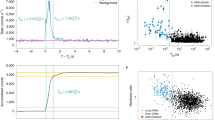Abstract
Nearly all of the known γ-ray bursts (GRBs), when observed over the energy range ∼30 keV to 1 MeV, have intensity spectra that can be described in terms of several-hundred-keV exponential functions. The Venera 11 and Venera 12 KONUS data indicate that, in addition to these ‘normal’ GRBs, there might exist a separate class of short, soft events1,2. There can be little doubt that bursts with spectra that seem anomalously soft (e-folding energy ≲30 keV) do exist, and that the most convincing known examples—GB790305b (the famous 5 March burst, including its follow-on events), GB790324 (and its follows-ons) and GB790930—generally have atypically short durations of ∼0.1–0.25 s. (Three of the 11 GB790305b follow-on events were longer3.) However, because most GRB instruments were designed primarily for observations above ∼100keV, events with very soft spectra have not been well enough studied to be classified unambiguously. Here we present the results of fortuitous detections of GB790107 (determined in ref. 2 to have a soft spectrum) with instrumentation better suited for the study of such bursts. Above 20 keV the spectrum is indeed much softer than any other cosmic event observed through the apertures of these experiments, and does not appear to belong to the general GRB spectral distribution. However, in the 5–15-keV range the spectrum is very flat. Statistical arguments indicate that soft-spectrum events might belong to a disk population, but this is not a strong conclusion.
This is a preview of subscription content, access via your institution
Access options
Subscribe to this journal
Receive 51 print issues and online access
$199.00 per year
only $3.90 per issue
Buy this article
- Purchase on Springer Link
- Instant access to full article PDF
Prices may be subject to local taxes which are calculated during checkout
Similar content being viewed by others
References
Mazets, E. P. et al. Astrophys. Space Sci. 80, 3–143 (1981).
Mazets, E. P., Golenetskii, S. V., Guryan Yu, A. & Ilyinski, V. N. Astrophys. Space Sci. 84, 173–189 (1982).
Golenetskii, S. V., Ilyinski, V. N. & Mazets, E. P. Nature 307, 41–42 (1984).
Anderson, K. A. et al. IEEE Trans. Geosci. Electron. GE-16, 157–159 (1978).
Barat, C. et al. Space Sci. Instrum. 5, 229–235 (1981).
Manchester, R. N. & Taylor, J. H. Astr. J. 86, 1953–1973 (1981).
Wackerling, L. R. Mem. R. astr. Soc. 73, 153–319 (1970).
Norris, J. P. et al. Nature 308, 434–435 (1984).
Barat, C. et al. Astrophys. J. 285, L791–L800 (1984).
Author information
Authors and Affiliations
Rights and permissions
About this article
Cite this article
Laros, J., Fenimore, E., Fikani, M. et al. The soft γ-ray burst GB790107. Nature 322, 152–153 (1986). https://doi.org/10.1038/322152a0
Received:
Accepted:
Issue Date:
DOI: https://doi.org/10.1038/322152a0
This article is cited by
-
Pulsars and Magnetars
Brazilian Journal of Physics (2013)
-
The strongest cosmic magnets: soft gamma-ray repeaters and anomalous X-ray pulsars
The Astronomy and Astrophysics Review (2008)
-
XMM–Newton observations of soft gamma-ray repeaters
Astrophysics and Space Science (2007)
-
Unveiling soft gamma-ray repeaters with INTEGRAL
Astrophysics and Space Science (2007)
Comments
By submitting a comment you agree to abide by our Terms and Community Guidelines. If you find something abusive or that does not comply with our terms or guidelines please flag it as inappropriate.



